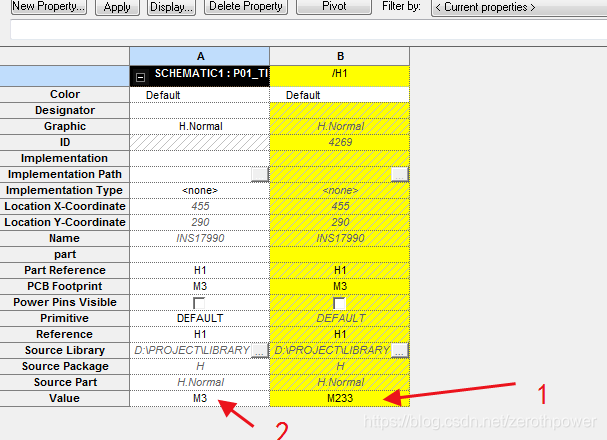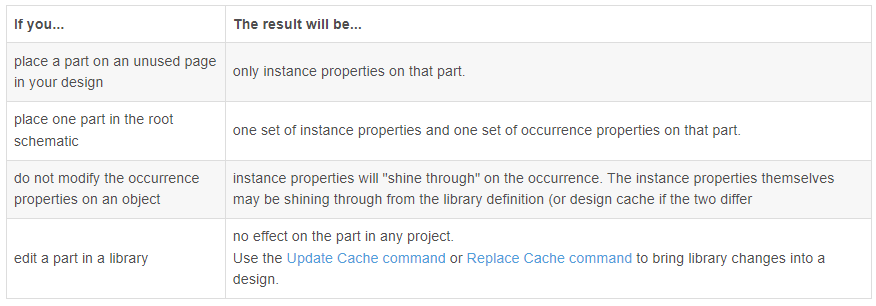用OrCAD设计原理图必须理解两个概念instance 和 occurrences。对于元件放置、替换、修改属性等很多操作都和这两个概念有关。
抛开抽象的说明,我们用实例说明他们的区别。假如你在自己的元件库中已经建立了一个元件AD8056(AD公司的运放)。在原理图page1中需要放入两个AD8056构成双路模拟信号输入的运放,那么在放入第一个AD8056时,在工程管理框的design cache中会出现这个元件以及所在的元件库地址,原理图的page1上出现AD8056原理图符号。这时就产生了一个instance 和一个occurrences,你可以把design cache中的AD8056看成instance,而原理图中的AD8056看成是一个occurrences。当你放第二个AD8056时,原理图的page1上出现第二个AD8056原理图符号,产生了另一个occurrences。也就是说,在原理图上放多少个AD8056就有多少个occurrences,但因为这些元件都是同一个元件库中取出来的,其各方面的属性都相,都是同一种元件,所以instance只有一个。因此可以把instance理解为元件种类,occurrences理解为个体实例。这里的种类指包括图形,属性等都相同的元件类型。如果图形相同,但属性不同,那么就不是同种元件,对应不同的instance。
理解这个概念最好的方法就是在原理图中修改instance。选中原理图中一个AD8056 occurrences,右键->edit part就可以修改该occurrences对应得instance,比如我们修改了某个管脚的输入输出属性,选择 updata current,你会发现在design cache中多出了一个名叫AD8056的instance,看看后面的来源地址,不是元件库地址,而是本设计的数据库。这样在你的设计中有两个instance,虽然都是AD8056,但是属性不同,可以认为不是同一种元件。如果再放置第三个AD8056,你就可以选这两个instance中的任何一个。
OrCAD Capture CIS 提供了灵活的instance和occurrences属性编辑功能,使设计更方便,但同时也更繁琐,只要理解了这两个概念,使用时注意,可以使原理图设计更灵活方便。
如果在occurrences里更新属性就会发现instance属性和occurrence属性不一样(properties下白色行和黄色行不一致),一致的方法一是Design->remove occurrence properties但是之前在occurrences更新的属性就会不见。
所以更新属性的时候最好选用Use instances
方法二是找到更新的值并且将黄色区域1的值复制到白色区域2 然后保存
参考 https://www.doc88.com/p-3923569641172.html?r=1


Part Instances and Occurrences
A part instance is a part you have placed on a schematic page. A part occurrence is created each time the part instance occurs in a schematic that is within the design hierarchy. So, for example, placing a part on a schematic page in your design creates both an instance and an occurrence. You can assign properties to the part instance, in which case the property (and its associated value) will "shine through" to each part occurrence unless the value is specifically replaced by a value on an individual part occurrence. The Property editor window graphically illustrates the state of instance and occurrence properties.
The instance property values shines through to the occurrence as long as the occurrence property values have not been edited in any way. When you explicitly edit an occurrence property value or when Capture modifies it via one of its tools, the occurrence values overrides the instance value. Only the occurrence value will be placed in the netlist.

How Capture uses instance and occurrence properties
The type of property you update or use in Capture depends on the type of project in which you are working.
If you are working with an FPGA project or a PSpice project, Capture allows you a choice, but defaults to update instances when you use the Annotate, Update Properties or Export Properties commands. It is best that you use instances to create Cross Reference and Bill of Materials reports, as well.
When you work with a PCB or schematic project, it is best to update occurrences when you use the Annotate, Update Properties, and Export Property commands. In these projects, Capture also uses occurrences to create reports with Cross Reference and Bill of Materials.
Icon
While modifying occurrence properties, open only one occurrence at a time.
The EDIF 2 0 0, VHDL, and Verilog netlist formats generate true hierarchical netlists. Capture uses the instance property values on nets and parts when it generates a netlist for a design with one of these formats. All other netlist formats in Capture produce flat netlists and use occurrence property values.
Preferred modes for design processing
Capture determines and recommends a preferred mode for processing your design based on the type of project flow, type of design with respect to complex or simple hierarchy, and whether occurrence properties already exist on the design.
The Cross Reference Parts dialog box is an example of where you can choose to use instances or use occurrences as the preferred mode.

原文链接:https://blog.csdn.net/zerothpower/article/details/109163656